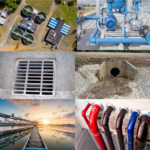Sewer systems quietly remove wastewater, keeping our communities clean and healthy. They are important for modern sanitation. But did you know that not all sewers are created equal? At Action Plumbing Heating, Air & Electric, we explain the different types of sewers and help you understand how they are different. If you own a home, business, or property, knowing about sewer systems can help you in maintaining, repairing, and upgrading them.
Understanding sewer systems is important for making informed decisions about maintenance, addressing problems, and enhancing the system. It is beneficial to be knowledgeable about sewer systems to make wise choices when it comes to upkeep, repairs, and upgrades.
Types of Sewers
1. Sanitary Sewers
Sanitary sewers carry wastewater from sinks, toilets, showers, and drains to treatment plants. They are also called foul sewers or wastewater sewers. These sewers carry “greywater” – water that comes from sources other than toilets – as well as “blackwater” – water containing human waste. Sanitary sewers are typically separate from storm sewers to prevent contamination during heavy rainfall or flooding events.
2. Storm Sewers
Storm sewers, as the name suggests, are dedicated to managing excess rainwater and surface runoff. They collect rainwater from streets, parking lots, and other paved surfaces, directing it away from buildings and into natural bodies of water or stormwater management systems. Unlike sanitary sewers, storm sewers do not handle wastewater from sinks or toilets. Instead, they focus solely on mitigating the risks of urban flooding and water pollution caused by stormwater runoff.
3. Combined Sewers
Combined sewers are a hybrid system that integrates both sanitary and storm sewer functions into a single network. These sewers collect both wastewater and stormwater runoff, transporting them to treatment plants or discharge points. While combined sewers offer cost savings by consolidating infrastructure, they can pose environmental challenges during heavy rainfall or snowmelt, leading to sewer overflows and contamination of waterways.
4. Sewer Laterals
Sewer laterals, also known as service laterals or house connections, are the pipes that connect individual properties to the main sewer lines. These lateral pipes are responsible for conveying wastewater from homes and businesses to the municipal sewer system. Proper maintenance of sewer laterals is essential to prevent blockages, leaks, and backups that can cause property damage and health hazards.
Why Understanding Sewer Types Matters
Understanding the different types of sewers is essential for property owners and managers for several reasons:
- Maintenance Planning: Knowing the type of sewer system on your property allows you to develop targeted maintenance plans and allocate resources effectively.
- Risk Management: Awareness of potential sewer issues, such as combined sewer overflows or stormwater backups, enables proactive measures to mitigate risks and protect property and public health.
- Regulatory Compliance: Compliance with local regulations and environmental standards regarding sewer management and wastewater discharge is crucial for avoiding fines and penalties.
Contact Us Today
Whether you’re dealing with a sewer repair, upgrade, or routine maintenance, Action Plumbing Heating, Air & Electric is here to help. Contact us today to speak with one of our knowledgeable technicians and schedule a sewer inspection or service appointment.
With our expertise and dedication to customer satisfaction, you can trust us to keep your sewer system running smoothly and efficiently. Act now to prevent sewer problems from getting worse. Make sure your property’s sewer system is working properly.


